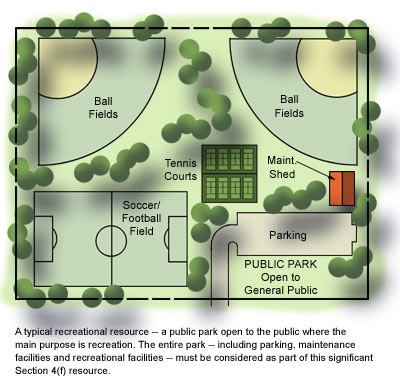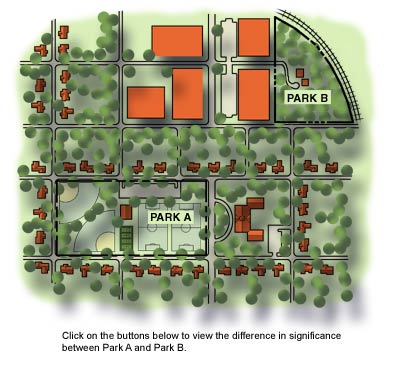Section 4(f) Properties
PARKS, RECREATION AREAS, AND REFUGES
Defining Criteria
Parks, recreation areas, and refuges are three common types of properties protected by Section 4(f). In order to qualify as a park, recreation area, or refuge under the statute, a property must meet all of the following criteria:
- It must be publicly owned
- It must be open to the public (except in certain cases for refuges as highlighted in the sections below)
- Its major purpose must be for park, recreation, or refuge activities
- It must be significant as a park, recreation area or refuge

Parks, Recreation Areas and Refuges Must be Publicly Owned
Public ownership in Section 4(f) refers to ownership by a local, state or Federal government agency. FHWA recognizes three types of public ownership:
- Fee simple ownership - the land is solely owned by a government entity for park, recreation or refuge purposes
- Permanent easement for Section 4(f) purposes - the land is not necessarily owned by a government agency, but the agency possesses an easement for Section 4(f) activities
- Lease agreement for Section 4(f) purposes - similar to a public easement but with a lease agreement typically intended for the long-term.
In cases where a public entity has an easement on the land or the land is leased to a public entity, the specifics of the easement or lease agreement must be examined on a case-by-case basis. Factors such as the terms of the easement or lease, the understanding of the parties to these terms, any reversion clauses and the like should be reviewed by FHWA in order to determine whether the terms of the agreement constitute public ownership for Section 4(f) purposes.
Parks, Recreation Areas and Refuges Must be Open to the Public
A property that is open to the public is one where access is permitted to the entire public during normal hours of operation. A property would not be considered open to the public if access was permitted only to select groups. For example, if a publicly owned recreational facility (such as a state university softball complex, for example) is open only to students, faculty and staff, then it would not be considered open to the public.
Wildlife and waterfowl refuges are treated somewhat differently when it comes to the issue of public access. Many wildlife and waterfowl refuges allow public access, while others may restrict public access either to sensitive areas or during certain times of the year for the protection of refuge habitat and species. A refuge would not have to provide unrestricted access to the public to be considered a Section 4(f) property.
Major Purpose Must be for Park, Recreation or Refuge Activities
Major purpose is related to the property’s primary function and how it is intended to be managed. Parks and recreation areas typically offer a wide range of activities such as walking, hiking or camping, for example, as well as organized sports like soccer, softball or tennis. Parks can also be fairly passive in nature. Refuges refer to properties that are formally part of the National Wildlife Refuge System, or other publicly owned land (including waters) where the major purpose of such land is the conservation, restoration, or management of endangered species, their habitat, and other wildlife and waterfowl resources and their habitat.
In order to determine a piece of land's major purpose, you will have to review its master and/or management plan (if one exists) to see if the purpose is explicitly stated and consult with the officials with jurisdiction over the land. Officials with jurisdiction are the agency or agencies that own or administer the property and are empowered to represent the agency on matters related to the property. In some cases, there may be more than one Federal, state or local agency that would be considered the officials with jurisdiction.
Lands used primarily for non-recreational purposes but where recreational activities that are incidental, secondary, occasional, or dispersed activities similar to park, recreation, or refuge activities take place are not considered Section 4(f) activities. An example would be occasional picnicking or art shows on the grounds of a city hall or other public building.
Parks, Recreation Areas and Refuges Must be Significant
The term "significant" means that in comparing the availability and function of the park, recreation area or refuge, with the park, recreation or refuge objectives of the agency, community or authority, the property in question plays an important role in meeting those objectives. Except for certain multiple-use land holdings, significance determinations are applicable to the entire property not just to the portion of the property proposed for use by a project. A determination of significance is made in coordination with the official with jurisdiction. Properties will be presumed significant in the absence of a determination by the official with jurisdiction. All determinations of significance are ultimately made by FHWA.
The meaning of significance may need to be explained to an official with jurisdiction. It is best described with an example of two parks.
 |
Alternate View |
The argument can be made that Park B is not considered significant. In order to make this determination you should review the community's park and recreational goals, which may be described in a master plan, and you should formally consult with the official with jurisdiction.
